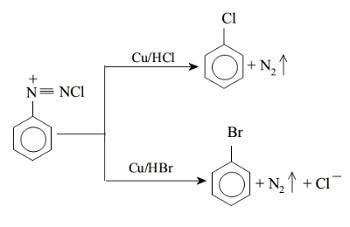
Explain Gattermann Reaction.
Answer
505.8k+ views
Hint : Gattermann reaction is used in the synthesis of aromatic compounds. Aromatic aldehyde and aromatic halide can be obtained from this reaction. It is also known as Gattermann formylation or Gattermann salicylaldehyde synthesis. This reaction is named after German Chemist Ludwig Gattermann. This reaction is similar to the Friedel Craft reaction.
Complete step by step solution:
Examples of Gattermann Reaction-

The yield in the Sandmeyer reaction is better than the Gattermann reaction. This reaction is a variation of the Sandmeyer reaction where copper chloride is replaced with copper powder. Thus the replacement leads to formation of aryl halide very easily. The yield is reduced under mild conditions in the Sandmeyer reaction.


Applications of Gattermann Reaction- It is used in the formation of chlorobenzene and bromobenzene. Products of this reaction are used in pharmaceuticals, agriculture and medicine such as benzaldehydes and haloarenes etc. It is useful in formation of benzaldehydes and aromatic halides.
Note : Hence we have learned about the Gattermann reaction and its applications. It is a kind of substitution reaction where electrophile attacks on benzene ring and by substituting components product is formed. This is a very famous reaction which is always used in the synthesis or preparation of aromatic halides.
Complete step by step solution:
Examples of Gattermann Reaction-

The yield in the Sandmeyer reaction is better than the Gattermann reaction. This reaction is a variation of the Sandmeyer reaction where copper chloride is replaced with copper powder. Thus the replacement leads to formation of aryl halide very easily. The yield is reduced under mild conditions in the Sandmeyer reaction.


Applications of Gattermann Reaction- It is used in the formation of chlorobenzene and bromobenzene. Products of this reaction are used in pharmaceuticals, agriculture and medicine such as benzaldehydes and haloarenes etc. It is useful in formation of benzaldehydes and aromatic halides.
Note : Hence we have learned about the Gattermann reaction and its applications. It is a kind of substitution reaction where electrophile attacks on benzene ring and by substituting components product is formed. This is a very famous reaction which is always used in the synthesis or preparation of aromatic halides.
Recently Updated Pages
Express the following as a fraction and simplify a class 7 maths CBSE

The length and width of a rectangle are in ratio of class 7 maths CBSE

The ratio of the income to the expenditure of a family class 7 maths CBSE

How do you write 025 million in scientific notatio class 7 maths CBSE

How do you convert 295 meters per second to kilometers class 7 maths CBSE

Write the following in Roman numerals 25819 class 7 maths CBSE

Trending doubts
Give 10 examples of unisexual and bisexual flowers

Draw a labelled sketch of the human eye class 12 physics CBSE

Differentiate between homogeneous and heterogeneous class 12 chemistry CBSE

Differentiate between insitu conservation and exsitu class 12 biology CBSE

What are the major means of transport Explain each class 12 social science CBSE

Draw a diagram of a flower and name the parts class 12 biology ICSE




